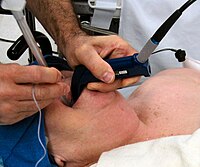
Photo from wikipedia
Background: The data on long-term nasotracheal intubation among mechanically ventilated critically ill children is limited. The purpose of this study was to compare the rate of post-extubation airway obstruction (PEAO)… Click to show full abstract
Background: The data on long-term nasotracheal intubation among mechanically ventilated critically ill children is limited. The purpose of this study was to compare the rate of post-extubation airway obstruction (PEAO) with nasotracheal and orotracheal intubation. Methods: This open-label randomized controlled trial was conducted in PICU of a tertiary care and teaching hospital in North India from January-December 2020 involving intubated children aged 3 months−12 years. After written informed consent, children were randomized into nasotracheal and orotracheal intubation groups. Post-extubation, modified Westley's croup score (mWCS) was used at 10-timepoints (0-min, 30 min, 1, 2, 3, 6, 12, 24, 36, and 48-h after extubation) to monitor for PEAO. The primary outcome was the rate of PEAO; and secondary outcomes were time taken for intubation, number of intubation attempts, complications during intubation, unplanned extubation, repeated intubations, tube malposition/displacement, endotracheal tube blockade, ventilator associated pneumonia, skin trauma, extubation failure/re-intubation, duration of PICU stay, and mortality. Results: Seventy children were randomized into nasotracheal (n = 30) and orotracheal (n = 40) groups. Both the groups were similar in baseline characteristics. The rate of PEAO was similar between nasotracheal and orotracheal groups (10 vs. 20%, p = 0.14). The maximum mWCS and mWCS at 10-timepoints were similar in two groups. The time taken for intubation was significantly longer (85 vs. 48 s, p < 0.001) in nasotracheal group, whereas other secondary outcomes were similar in two groups. Conclusion: The rate of PEAO was not different between nasotracheal and orotracheal groups. Clinical Trial Registration: http://ctri.nic.in, Identifier: CTRI/2020/01/022988.
Journal Title: Frontiers in Pediatrics
Year Published: 2021
Link to full text (if available)
Share on Social Media: Sign Up to like & get
recommendations!